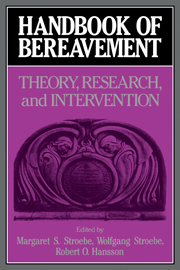Book contents
- Frontmatter
- Contents
- Contributors
- Preface
- Part I Introduction
- Part II The phenomenology and measurement of grief
- Part III Current theories of grief, mourning, and bereavement
- Part IV Physiological changes following bereavement
- Part V The psychological, social, and health impacts of conjugal bereavement
- 12 The mortality of bereavement: A review
- 13 Psychological resilience among widowed men and women: A 10-year follow-up of a national sample
- 14 Determinants of adjustment to bereavement in younger widows and widowers
- 15 The impact of spousal bereavement on older widows and widowers
- 16 The course of spousal bereavement in later life
- 17 Risk factors in bereavement outcome
- Part VI Grief reactions to different types of loss
- Part VII Coping, counseling, and therapy
- Part VIII Conclusions
- References
- Author index
- Subject Index
13 - Psychological resilience among widowed men and women: A 10-year follow-up of a national sample
Published online by Cambridge University Press: 04 May 2010
- Frontmatter
- Contents
- Contributors
- Preface
- Part I Introduction
- Part II The phenomenology and measurement of grief
- Part III Current theories of grief, mourning, and bereavement
- Part IV Physiological changes following bereavement
- Part V The psychological, social, and health impacts of conjugal bereavement
- 12 The mortality of bereavement: A review
- 13 Psychological resilience among widowed men and women: A 10-year follow-up of a national sample
- 14 Determinants of adjustment to bereavement in younger widows and widowers
- 15 The impact of spousal bereavement on older widows and widowers
- 16 The course of spousal bereavement in later life
- 17 Risk factors in bereavement outcome
- Part VI Grief reactions to different types of loss
- Part VII Coping, counseling, and therapy
- Part VIII Conclusions
- References
- Author index
- Subject Index
Summary
Students of stress, illness, and adaptation have taken a particular interest in bereavement, and with good reason. Death of a spouse is consistently rated as the most stressful of normative events (Holmes & Rahe, 1967), requiring the maximal readjustment in life; it is also a common experience, which nearly half the population will eventually face. The intensity and frequency of this stressor make it of undeniable social importance. At the same time, there are powerful methodological advantages to the study of bereavement for an understanding of stress, coping, and adaptational processes. Because death of spouse is an objectively verifiable event generally beyond the control of the widowed individual, artifacts that plague the study of stress and illness (Schroeder & Costa, 1984) can be minimized.
The results of bereavement studies provide mixed support for the view that life stress causes subsequent mental and physical illness and mortality. Some studies show excess mortality, particularly for males, in the year or two following bereavement (Helsing, Szklo, & Comstock, 1981; Parkes, Benjamin, & Fitzgerald, 1969), but there are methodological difficulties with most studies of mortality (M. Stroebe, Stroebe, Gergen, & Gergen, 1981; Susser, 1981). Studies of health after bereavement are also complicated by the problems of disentangling subjective health perceptions from objective disease processes (Costa & McCrae, 1985a), and one of the few studies to use as control variables baseline measures taken before the loss event concluded that, “using a variety of health indicators, the effects of these [bereavement] events were either nonexistent or slight and brief.
- Type
- Chapter
- Information
- Handbook of BereavementTheory, Research, and Intervention, pp. 196 - 207Publisher: Cambridge University PressPrint publication year: 1993
- 19
- Cited by

